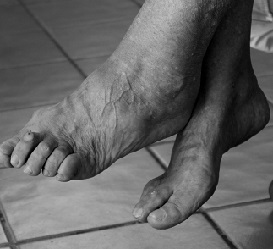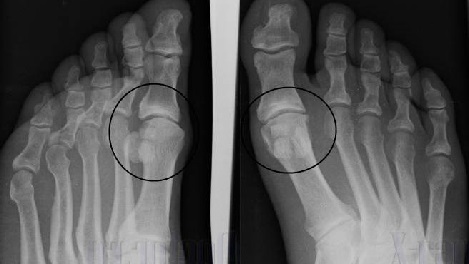 What it is? Arthrosis of the foot is a degenerative and dystrophic process that affects its joints (deforming osteoarthrosis of the foot joints).For the disease is characterized by the gradual destruction of cartilaginous tissue, in the place of which appear bony growths that limit mobility in the joints.
What it is? Arthrosis of the foot is a degenerative and dystrophic process that affects its joints (deforming osteoarthrosis of the foot joints).For the disease is characterized by the gradual destruction of cartilaginous tissue, in the place of which appear bony growths that limit mobility in the joints.
Sometimes these bony growths (osteophytes) can lead to reactive irritation of the synovium, which is accompanied by the development of reactive arthritis. This is what causes the diagnostic errors between deforming osteoarthritis and arthritis, for the treatment of which fundamentally different approaches are used.
Arthrosis of the foot is a fairly common disease. So, according to statistical data, it occurs in 10-15% of cases, and its prevalence increases with age. However, at the present time this pathology also occurs at a young age.
Causes of development
Why does arthrosis develop and what is it? From the point of view of causative factors this disease must be classified into primary arthrosis and secondary. With the primary changes develop on the unchanged cartilage as opposed to the secondary.
Currently, the final factors that lead to the development of this disease have not been established. However, a group of conditions that increase the likelihood of developing foot arthrosis is isolated. These include:
- increased mechanical stress on the joints;
- violation of microcirculation in the cartilage;
- metabolic disorders, in which there is an excessive accumulation of certain chemicals in the joint, have an irritating and destructive effect (for example, the accumulation of uric acid in gout);
- the pathology of the immune system, in which it begins to destroy the cartilaginous tissue;
- long walking;
- chondrodystrophic processes;
- obesity;
- hypermobility of the joints;
- burdened heredity, etc.
For the joints of the foot in the role of predisposing factors can also act:
- flat feet;
- traumatic foot injury;
- occupational hazards.
Orthopedic treatment depends on the severity of the degenerative-dystrophic process, therefore the following methods can be used:
- wearing fixative bandages;
- use of orthopedic walking sticks and crutches;
- operative intervention.
Symptoms of foot arthrosis
Of all the joints of the foot, arthrosis most often affects the first metatarsal-phalanal joint. The peculiarities of this pathological process, which leaves an imprint on the clinical picture, appear the following symptoms of arthrosis:
- very often the process is two-sided;
- pain in the area of the first toe;
- limitation of its mobility;
- a feeling of discomfort;
- difficulties during walking;
- joint deformity due to growth of osteophytes;
- valgus deviation of the big toe, that is, to the outside.
Wearing tight and uncomfortable shoes creates conditions for additional injury to the joint, which aggravates the course of the pathological process. This is expressed in the following:
- Progression of deforming osteoarthritis;
- Bursitis is an inflammatory lesion of the periarticular bag.
Diagnostics
Diagnostics of deforming osteoarthrosis of the foot primarily involves an X-ray study. The main criteria on which the diagnosis is based are:
- reduction in the size of the gap between the articular surfaces;
- presence of cysts in bone tissue;
- subchondral increase in bone density, which gradually progresses;
- incomplete and then complete dislocation of the head of the first bone of the metatarsal.
Based on the data of the X-ray study, you can set the degree of deforming osteoratrosis. And it is necessary to determine the further tactics of treatment and determine the indications for the operation.
 Photo of foot arthrosis on an x-ray.
Photo of foot arthrosis on an x-ray.Complications
Complications that can develop against the background of arthrosis of the foot are not as tragic as with arthrosis of the hip joint.
Against the background of the progression of the disease, the complete immobility of the affected joint gradually develops, which leads to lameness. Patients with this disease rarely become invalids, that is, they do not lose their ability to self-service and fulfill their professional duties.
Treatment of foot arthrosis
The treatment of deforming arthrosis of the joints of the foot pursues the solution of the following tasks:
- Slowing down the progression of the pathological process;
- Reduction of pain syndrome;
- Treatment of developed synovitis (bursitis);
- The maximum possible restoration of the function of the affected joint.
To realize the tasks, methods of not only conservative treatment, but also methods of orthopedic correction can be applied. In the framework of conservative therapy, with which, as a rule, the treatment of foot arthrosis begins, drugs from the following pharmacological groups are prescribed:
- Chondroprotectors, which enable the activation of chondroblasts involved in the synthesis of cartilaginous tissue, which contributes to its recovery.
- Nonsteroidal anti-inflammatory drugs that suppress the severity of the inflammatory reaction and thereby reduce the severity of the pain syndrome.
- In more severe cases, it is shownuse of corticosteroids(hormonal) drugs, which have a stronger anti-inflammatory effect.
- Antiaggregants, which normalize microcirculation in the subchondral zone, which slows the progression of the pathological process.
- Application of methodsphysiotherapeutic treatment, which have a complex therapeutic effect on the joint.
- Massage and physiotherapy exercises, which partially allow to restore the function of the broken joint and improve the condition of the muscles.
Prevention
Effective prophylaxis, which would reliably prevent the development of deforming osteoarthritis of the foot, is currently absent.
However, one should follow such recommendations as:
- Normalization of body weight to combat excess weight;
- Elimination of foot injury;
- Wearing comfortable shoes of suitable size;
- Timely correction of flat feet;
- Previously, the identification of any pathological process that predisposes to this disease.

How to choose probiotics for the intestine: a list of drugs.

Effective and inexpensive cough syrups for children and adults.

Modern non-steroidal anti-inflammatory drugs.

Review of tablets from the increased pressure of the new generation.
 Antiviral drugs are inexpensive and effective.
Antiviral drugs are inexpensive and effective.



